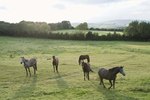
A green broke horse is one who has recently learned to accept a rider on his back, or to be "under saddle." But “green broke” has various shades of meaning. The only way to know what a horse knows is to spend some time with him so you can map a training path. At a minimum, you know he’s inexperienced.
Ground Commands
If you just acquired your green horse, don’t climb on him until you assess what he knows. The safe way to do this is on the ground, either in a round pen or with him on a lunge line. With the horse tracking left in a circle, raise your lunge whip, point it toward his hip and ask him to walk. If he doesn’t move forward, wiggle the whip slightly and ask again. If he breaks into a trot or canter, let him go for a few seconds then ask him to whoa; then walk again. Some horses are not taught to walk on a lunge line -- only to trot and canter. Do not get on a green horse until he knows commands for walk, trot, canter and whoa on the ground.
Bit Pressure
Bridle your horse and pick up one rein to see how quickly and easily he responds by flexing his neck in the direction of the pressure. If he resists, he has not learned to give to bit pressure. Work with him on each side, and then, if you feel qualified, lunge him in side reins. Slowly increase the tension until they are adjusted to his natural head set, which is where he holds his head naturally at rest. If you are unsure of how to use side reins, ask an experienced horse rider or trainer to demonstrate the process and to supervise you for a few sessions.
Walking Exercises
Once you start riding your green horse, ask him to transfer the basics he learned on the ground to under-saddle work. After you mount, ask him to walk forward a few steps and then whoa, or halt. Then, ask him to yield to your leg. For example, if you want him to move left, apply pressure with your outside or right leg. Next, ask for some lateral flexion by picking up your inside rein while applying pressure at the girth with your inside leg. This should cause him to turn naturally into a circle. Work on performing these correctly at the walk. Don’t overwork him; quit before you sense he’s getting bored or frustrated, and definitely quit before you get frustrated. Take him out of the arena for a change of pace.
Physical Considerations
Most green horses are not in prime physical condition; they just haven’t had enough correct riding to strengthen their hindquarters, abdomen and back. You also need to protect their joints and tendons. You want to gradually increase physical activity, but if you add time to each ride, don’t increase the intensity level. For example, if you’ve been walking and trotting for 25 minutes and decide to add the canter, don’t exceed 25 minutes for a few days.
Get off your green horse’s back when you walk and canter. Do this by posting the trot as much as possible and getting in a half-seat or two-point position when you canter. Learning to balance himself while carrying your weight is a major task for the green horse; let him find his own balance before you ask him to fully support yours. Sit the trot only for a few strides, such as before asking him to canter.
References
Resources
Photo Credits
-
Thinkstock/Comstock/Getty Images
Writer Bio
Based in Central Texas, Karen S. Johnson is a marketing professional with more than 30 years' experience and specializes in business and equestrian topics. Her articles have appeared in several trade and business publications such as the Houston Chronicle. Johnson also co-authored a series of communications publications for the U.S. Agency for International Development. She holds a Bachelor of Science in speech from UT-Austin.




